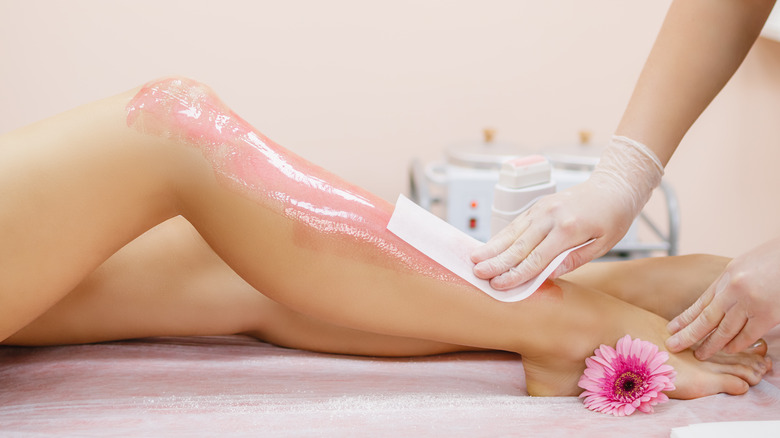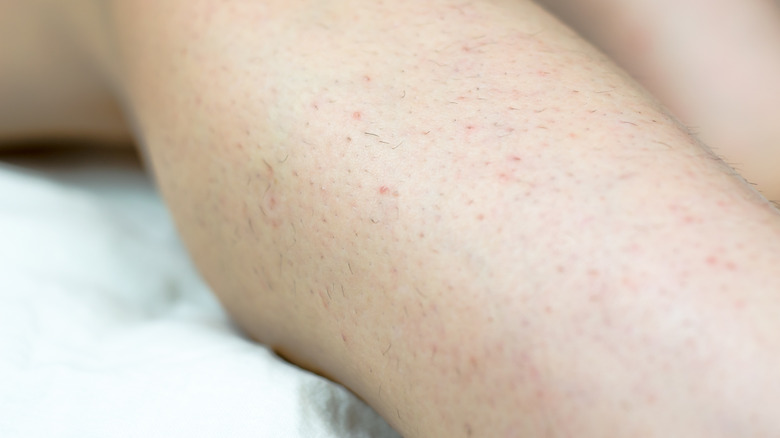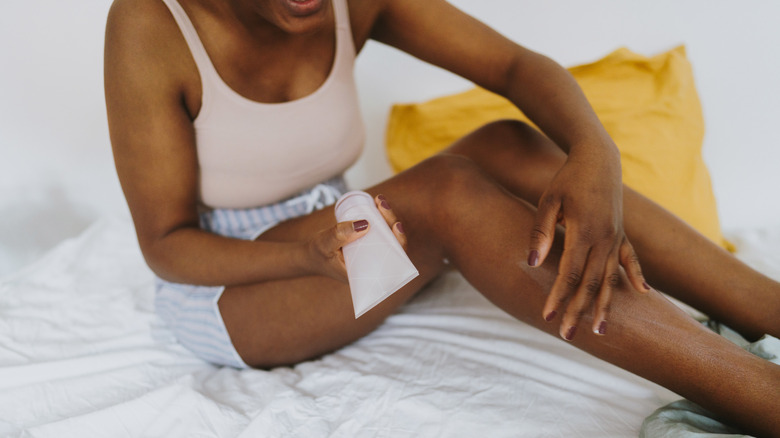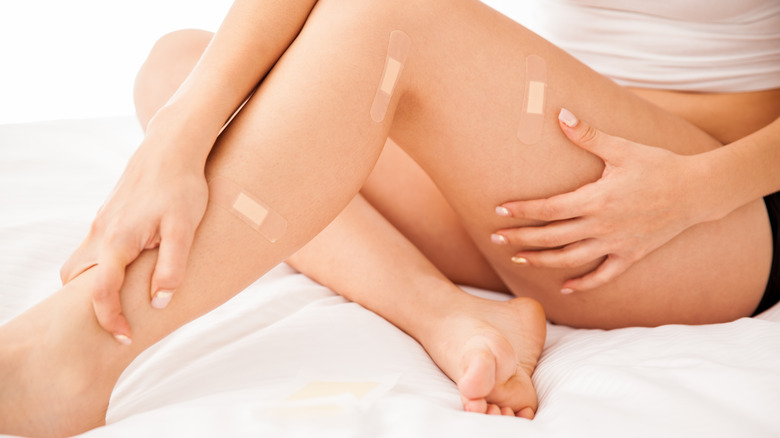Shaving To Waxing: Here's Exactly How To Make The Switch
Women have been under societal pressure to remove the hair from their legs and underarms since they began baring them on a large scale in the 1920s. Razor manufacturers, of course, jumped at the chance to expand their market as soon as short skirts and sleeveless shirts hit the market, and the rest is history. The options for how women remove their body hair, however, have expanded in the many decades since.
Waxing has long been considered the queen of hair removal, offering smoother and longer-lasting results than shaving or depilatories. Maintaining a regular waxing regime, though, can be a bit time-consuming and cost prohibitive, depending on your budget and schedule. As a result, even waxing enthusiasts often end up shaving and then struggle to figure out how to transition back to regular waxing. With just a bit of patience and preparation, however, you can slide right back into your waxing routine or start a brand-new one with ease.
Hair regrowth
The convenience of shaving is that it can be done quickly and inexpensively as often as every day. If you have a strong aversion to hair on your body, this provides you with a way to never have more than a small amount of stubble in the areas you shave. Waxing, on the other hand, requires you to grow hair out to a minimum of ¼ inch to enable the wax to adhere enough to pull the hair out by its roots.
If you've been shaving but would like to switch to waxing, there is no way around the regrowth period. When it comes to effective waxing, especially for the first time, hair closer to ½ inch long is even better. For freshly shaved legs, it will typically take at least two weeks to grow your hair long enough to qualify for waxing. Even if you think your hair has surpassed ¼ inch during this time, do not attempt to trim it in case you accidentally go too short and reset the clock.
Hydration vs. moisturization
You'll want the skin on your legs to be hydrated and healthy before you go in to have them waxed, but this doesn't mean slathering them with tons of moisturizer on the day of or the night before your appointment. Moisturizers actually sit on top of the skin to seal in hydration, which can prevent wax from being able to adhere to the hair on your body. As you wait for your hair to grow out to a safe length, thoroughly moisturize on a regular basis for hydrated skin beyond the surface on wax day. If your skin tends to get dry, consider applying a body oil on top of your moisturizer to seal hydration in.
On the day of your waxing appointment, do not apply moisturizer or any other topical product to your legs. At that point, it's too late to hydrate, and you'll want to focus on cleaning your skin instead. Shower as you normally would, but skip any lotions or creams you usually apply until 48 hours after your waxing is finished.
Exfoliation
Exfoliation removes dead skin cells from the surface of your skin. During the waxing process, hair is pulled out of the pores. If the pores are exposed to excess dead skin cells, they could end up blocked once the hair is gone, increasing the chances of ingrown hairs developing during the regrowth process. Much like hydration, exfoliation cannot be pushed off until the day of your appointment. Since exfoliating and waxing can both irritate your skin, you'll need to exfoliate a couple of days before your waxing appointment.
For the purpose of preparing for waxing, it's best to opt for a gentle mechanical exfoliant — like a sugar scrub or a mitt — over a chemical option. While chemicals can be more effective at removing dead skin cells, they penetrate much deeper into the skin, which can increase the chances of irritation developing when they're used too close to waxing. Keep it simple and gentle, especially closer to your appointment.
Pain tolerance
If you're a former waxer who fell into the habit of shaving for a while, you should have a good idea of how tolerable the pain of waxing feels on your personal scale. If you struggled to handle the pain when you were waxed in the past or if you've never been waxed before and generally have a low pain tolerance, you may wish to take an over-the-counter anti-inflammatory medication such as ibuprofen or naproxen. Taking one of these an hour before your waxing appointment can prevent some of the painful inflammation that can follow the procedure, though it won't eliminate the pain of waxing.
The American Academy of Dermatology Association also recommends icing your skin with a cold pack to lightly numb the area. If you're struggling with anxiety over the potential pain of the procedure, try to calm your nervous system before your appointment — getting waxed when you're tense and stressed out actually makes the sensations feel more painful. Before you walk into your appointment, take a moment to sneak in a micro-meditation to calm your mind and relax your body.
Aftercare
Waxing is a more invasive procedure than shaving since it involves forcefully removing hair by the roots. While this means smoother legs for longer, it also means a higher chance of complications and more necessary care after waxing. After your waxing appointment, you'll want to avoid heat for the next 48 hours; this includes hot showers or baths, hot tubs, and saunas. When it's time to shower again, keep the water cool or lukewarm — as board-certified dermatologist Dr. Hope Mitchell advised Women's Health — and avoid scented body washes to prevent more irritation. You should also avoid swimming, prolonged sun exposure, and tanning, including spray tans. Your workout plan should be paused for a couple of days after waxing to let your body recover.
Minimizing contact with the waxed area is key, so be sure to wear loose-fitting clothing to your appointment and continue to wear clean, comfortable, low-friction clothes for the next few days. Wash or sanitize your hands before touching the waxed area to avoid transmitting bacteria that could lead to an infection. Do not apply any products other than an antiseptic lotion to the waxed area for 48 hours, according to The Remedy Room; once this 48-hour window has passed, it's safe to resume your normal activities, including your usual moisturizing and exfoliating routine.
Risks: waxing vs. shaving
It may be true that waxing is a slightly more serious skin procedure that carries more risks than shaving, but that doesn't mean that shaving is risk-free. All forms of hair removal come with potential risks and side effects you'll want to consider before deciding which method is right for you. The typical risks associated with shaving include cuts, razor burn, and ingrown hairs (per Healthline). If you're using a razor blade that hasn't been replaced recently, there is also the risk of cuts becoming infected.
Waxing similarly carries the risk of infection and ingrown hairs. In addition, the procedure can cause redness and irritation, pain, sensitivity to heat and sunlight, and allergic reactions that can lead to scarring. If you have very dry or sensitive skin or take certain medications, there is a chance that waxing could tear your skin. For many, the longer-lasting results associated with waxing make it worth the longer list of potential side effects — but this is a personal decision for each person who makes the choice to remove their body hair.
Results: waxing vs. shaving
When you shave, you're simply trimming the hair at the surface of the skin, which allows hair to start growing back almost immediately. To maintain skin that feels smooth and hairless, you may need to shave every day or two. Waxing, in comparison, removes hair from the root deep below the skin's surface. This means that when the hair starts to regrow, it remains below the skin until it reaches the surface, which typically takes three or four weeks.
While having three to four weeks of results from one procedure sounds fantastic, it's important to consider the fact that you'll be required to grow the hair back out to at least ¼ inch before you can wax again. This is why it is generally recommended to wait four to six weeks between waxing appointments, even though your hair will start to visibly regrow after about three weeks. If you hate having body hair at all, that might make waxing a difficult routine to manage.
How to set a waxing schedule
Creating a regular waxing routine takes consideration of more than just how long your hair takes to become stubbly or visible again; you'll also need to consider how much time it takes to regrow your hair to at least ¼ inch. Another factor to consider is that some people experience damage to the hair follicles during repeated waxing, which results in thinner hair and less overall hair growth, according to the Canadian Dermatology Association. This suggests that sticking to a waxing routine can pay off over time.
Since it takes about four weeks for your skin cells to regenerate, you should never wax more than once a month to avoid overwaxing. Overwaxing can result in issues like increased skin irritation and hyperpigmentation. Instead, start with scheduling your waxing appointments every six weeks. If you routinely experience a bothersome amount of regrowth between appointments, gradually move your appointments closer together until you find the ideal waxing schedule for you.








